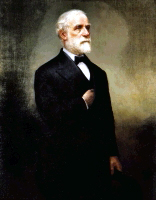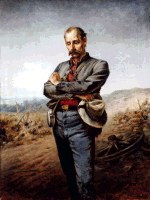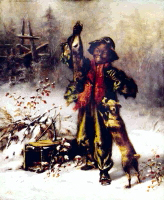 J.A. Elder painted this
oil portrait
J.A. Elder painted this
oil portrait
of Robert E. Lee about 1870.
SPACER
|
 Elder's oil painting
'After Appomattox'
Elder's oil painting
'After Appomattox'
dates to about 1880.
|
John
Adams Elder: Fredericksburg's Civil War
Artist
by Michael Aubrecht, The Free
Lance-Star: TOWN & COUNTY Feature
Date published: 11/17/07 Section: CIVIL WAR
Also online at: Fredericksburg Museum showcases
work by John Adams Elder
Standing amid the soldiers' and
civilians' graves in the Confederate Cemetery on
Washington Avenue is a simple, elegant marker with
the name "Elder" etched across its face. To the
casual observer, this tombstone would probably
blend in with the rest of the surroundings, but the
seasoned art enthusiast or historian would
recognize it as the final resting place of one of
the area's most famous artists, John Adams
Elder.
Somehow it seems fitting to find
such a grave here, because Fredericksburg has
always been a town known for two things: history
and art. In fact, there are probably just as many
visitors who journey to the Historic District each
year in search of fine antiques and paintings as
there are touring its hallowed battlefields and
museums. Both groups would most likely be impressed
with the historical contributions of the man named
Elder.
Born in Fredericksburg in 1833,
this extremely gifted painter of landscapes,
portraits and historical vignettes grew to become
one of the country's most cherished artists.
For
the first time since 1947, a retrospective of
Elder's work is on exhibition in his hometown. The
show at the Fredericksburg Area Museum and Cultural
Center is titled "John Adams Elder:
Fredericksburg's Artist of the Civil War" and
features numerous landscapes, portraits and genre
paintings of the War Between the States and life in
the South.
However, painting represents only
one side of this man, whose legacy is also that of
a local citizen-soldier.
DEFINING HIS STYLE
With dreams of specializing in the
genre of realism, the artist journeyed north at the
age of 17 to study the art of portrait rendering in
New York City. Then he traveled overseas to study
for five years in Dusseldorf, Germany, under the
guiding hand of Emanuel Leutze, who was renowned
for his brilliant depiction titled "Washington
Crossing the Delaware."
It
was during this time that Elder began to define the
wonderful style that would make his work celebrated
in the eyes of collectors for generations to
come.
Returning to the United States in
1856, he went back to the Big Apple, intent on
refining his skills and establishing a reputation
as an in-demand professional. In October of that
year, the up-and-coming master had his first
"showing" with a painting that was exhibited at the
Richmond Mechanic Institute. Immediately, viewers
recognized that there was something promising in
this man's work.
Even today, experts cite Elder's
unique ability to capture the emotion of his
subjects. No doubt his obvious affinity for
observation enabled the artist to mimic the
expressions of those he depicted.
ARTIST ENLISTS
Confident of his craft, he came
back to his home in 1860 to pursue a career in the
field of commissioned illustrations. After
dedicating 16 years to study, Elder had finally
become a respected portrait and landscape artist.
That plan changed in December of 1862, after
Federal forces bombarded his beloved town in the
early stages of the Battle of Fredericksburg,
damaging his house in the process.
Filled with outrage and disgust for
the Federal army's heinous acts against his fellow
civilians, Elder immediately enlisted in the
Confederate army and was later present at the
pivotal Battle of the Crater in Petersburg. Despite
the unpleasant memories of that encounter, he would
later go on to paint what is considered the
definitive painting of the engagement.
Following the surrender of the
Confederate forces in April 1865, the battle-weary
artist returned to the area, working in
Fredericksburg and Richmond. During the postwar
period, Elder painted some of the most prominent
men and women of the era. His works included
portraits of Gens. Robert E. Lee and Thomas J.
"Stonewall" Jackson, as well as several statesmen
and the former president of the Confederate States
of America, Jefferson Davis.
In
addition to capturing the area's elite on canvas,
he also painted a plethora of endearing scenes of
families and children (both white and black) living
the simple country life in the South.
Ironically, this fortunate war
veteran, who had survived one of the most violent
periods in American history, contracted a
life-threatening case of malaria while painting a
portrait of Jefferson Davis in Biloxi, Miss.
Complications from the illness, compounded by his
penchant for abusing alcohol, rendered him
virtually incapacitated for the last five years of
his life.
Elder succumbed to his ailment in
1895, breathing his last at his home/studio at 111
Main St. (now Caroline Street). He was buried in
the local Confederate Cemetery among his fallen
comrades.
 'Catching the Hare' is the
title
'Catching the Hare' is the
title
of this oil painting by Elder.
SPACER
|
CELEBRATING THE
SOUTH
Today, the works of John
Adams Elder remain the most coveted of
pre- and post-Civil War portraiture. In
the civilian pieces titled "Eating
Watermelon" and "Catching the Hare," Elder
demonstrated what made his work so
special. With tremendous attention to
detail and an absolute command of light
and shadow, the painter masterfully
captured the innocence of two
African-American boys simply doing what
boys do.
|
Yet
in his formal portraiture, Elder was able to
illustrate the stately side of his famous subjects
without depicting them as distant or
unapproachable.
The
collection of Elder's art is on display at the
Fredericksburg Area Museum and Cultural Center
through Sept. 7, 2008. It is on loan from the State
Art Collection of the Commonwealth of Virginia and
other private sources.
According to curatorial assistant
Christopher O. Uebelhor, "The Fredericksburg Museum
is delighted to have an opportunity to display such
a large collection of this important artist's
paintings, as well as several of his personal items
and sketches."
He
added, "Elder's work played a significant role in
postwar America, helping to perpetuate the idea of
the glorious Old South and the 'Southern mystique,'
which is still very much alive today."
SIDEBAR:
See
Artist's Work: John Adams Elder's artwork is on
display at the Fredericksburg Area Museum and
Cultural Center, 907 Princess Anne St., through
Sept. 7, 2008. The museum is open 10 a.m. to 5 p.m.
daily and 1-4 p.m. Sunday. Museum admission is $7
for adults; $5 for senior citizens and active
military. For details, call 540/371-3037.
MICHAEL AUBRECHT is a historian
from Spotsylvania County. He is currently working
on his fourth book, titled "Houses of the Holy:
Historic Churches of Fredericksburg." For more
information, visit his Web site at
pinstripepress.net.
Images courtesy of State Art
Collection of the Commonwealth of Virginia, The
Library of Virginia
|